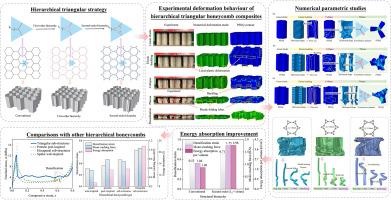Out-of-plane energy absorption of 3D printed basalt-fiber-reinforced hierarchical honeycomb composite
IF 7.1
1区 工程技术
Q1 ENGINEERING, MECHANICAL
International Journal of Mechanical Sciences
Pub Date : 2024-10-16
DOI:10.1016/j.ijmecsci.2024.109784
引用次数: 0
Abstract
This work presents a new type of hierarchical triangular honeycomb created by iteratively replacing each vertex of conventional hexagonal cells with a smaller equilateral triangle. The combination of green and recyclable short basalt-fiber-reinforced composite with advanced additive manufacturing technology makes it possible to design and fabricate the 3D printed hierarchical triangular honeycomb composites with exceptional mechanical properties for energy absorption applications. Out-of-plane quasi-static compression tests were performed on the 3D printed hierarchical honeycomb composite to investigate the compressive response and deformation behaviour of hierarchical triangular honeycombs. Parametric studies were conducted using ABAQUS/Explicit finite element code to study the effects of structural hierarchy and triangular cell size on mechanical properties and energy absorption of 3D printed hierarchical triangular honeycombs. The result revealed that the 3D printed hierarchical triangular honeycomb composite experienced a large and stable plastic deformation to densification without fracture failure resulting in excellent energy absorption. The second level triangular honeycomb composite exhibited the most promising mechanical properties. After optimization of the triangular cell size, the mean crushing force and specific energy absorption of the second level triangular honeycomb composite were about 1.7 times and 2.0 times those of the conventional hexagonal honeycomb composite. Compared to other typical hierarchical honeycombs, the proposed hierarchical triangular honeycomb composite exhibited higher plateau stress and larger densification strain, thus providing some insights in designing lightweight, recyclable and sustainable 3D printed honeycomb composites with superior mechanical properties.

三维打印玄武岩纤维增强分层蜂窝复合材料的平面外能量吸收
这项研究提出了一种新型分层三角形蜂窝材料,它是通过用一个较小的等边三角形迭代替换传统六边形单元的每个顶点而产生的。绿色、可回收的短玄武岩纤维增强复合材料与先进的增材制造技术相结合,使设计和制造具有优异机械性能的 3D 打印分层三角形蜂窝复合材料成为可能,并可用于能量吸收应用。对三维打印分层蜂窝复合材料进行了平面外准静态压缩试验,以研究分层三角形蜂窝的压缩响应和变形行为。使用 ABAQUS/Explicit 有限元代码进行了参数研究,以研究结构层次和三角形单元尺寸对三维打印分层三角形蜂窝的力学性能和能量吸收的影响。结果表明,3D 打印分层三角形蜂窝复合材料在致密化过程中经历了较大且稳定的塑性变形,没有断裂失效,因而具有良好的能量吸收能力。第二层三角形蜂窝复合材料表现出最有前途的机械性能。优化三角形单元尺寸后,第二层三角形蜂窝复合材料的平均压碎力和比能量吸收分别是传统六边形蜂窝复合材料的 1.7 倍和 2.0 倍。与其他典型的分层蜂窝相比,所提出的分层三角形蜂窝复合材料表现出更高的高原应力和更大的致密化应变,从而为设计具有优异力学性能的轻质、可回收和可持续的三维打印蜂窝复合材料提供了一些启示。
本文章由计算机程序翻译,如有差异,请以英文原文为准。
求助全文
约1分钟内获得全文
求助全文
来源期刊

International Journal of Mechanical Sciences
工程技术-工程:机械
CiteScore
12.80
自引率
17.80%
发文量
769
审稿时长
19 days
期刊介绍:
The International Journal of Mechanical Sciences (IJMS) serves as a global platform for the publication and dissemination of original research that contributes to a deeper scientific understanding of the fundamental disciplines within mechanical, civil, and material engineering.
The primary focus of IJMS is to showcase innovative and ground-breaking work that utilizes analytical and computational modeling techniques, such as Finite Element Method (FEM), Boundary Element Method (BEM), and mesh-free methods, among others. These modeling methods are applied to diverse fields including rigid-body mechanics (e.g., dynamics, vibration, stability), structural mechanics, metal forming, advanced materials (e.g., metals, composites, cellular, smart) behavior and applications, impact mechanics, strain localization, and other nonlinear effects (e.g., large deflections, plasticity, fracture).
Additionally, IJMS covers the realms of fluid mechanics (both external and internal flows), tribology, thermodynamics, and materials processing. These subjects collectively form the core of the journal's content.
In summary, IJMS provides a prestigious platform for researchers to present their original contributions, shedding light on analytical and computational modeling methods in various areas of mechanical engineering, as well as exploring the behavior and application of advanced materials, fluid mechanics, thermodynamics, and materials processing.
 求助内容:
求助内容: 应助结果提醒方式:
应助结果提醒方式:


